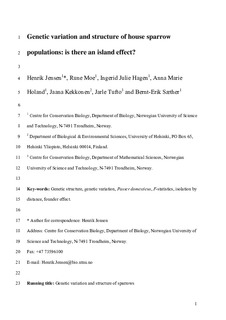| dc.contributor.author | Jensen, Henrik | |
| dc.contributor.author | Moe, Rune | |
| dc.contributor.author | Hagen, Ingerid Julie | |
| dc.contributor.author | Holand, Anna Marie | |
| dc.contributor.author | Kekkonen, Jaana | |
| dc.contributor.author | Tufto, Jarle | |
| dc.contributor.author | Sæther, Bernt-Erik | |
| dc.date.accessioned | 2017-10-30T12:33:02Z | |
| dc.date.available | 2017-10-30T12:33:02Z | |
| dc.date.created | 2013-01-17T18:20:56Z | |
| dc.date.issued | 2013 | |
| dc.identifier.citation | Molecular Ecology. 2013, 22 (7), 1792-1805. | nb_NO |
| dc.identifier.issn | 0962-1083 | |
| dc.identifier.uri | http://hdl.handle.net/11250/2462882 | |
| dc.description.abstract | Population genetic structure and intrapopulation levels of genetic variation have important implications for population dynamics and evolutionary processes. Habitat fragmentation is one of the major threats to biodiversity. It leads to smaller population sizes and reduced gene flow between populations and will thus also affect genetic structure. We use a natural system of island and mainland populations of house sparrows along the coast of Norway to characterize the different population genetic properties of fragmented populations. We genotyped 636 individuals distributed across 14 populations at 15 microsatellite loci. The level of genetic differentiation was estimated using F-statistics and specially designed Mantel tests were conducted to study the influence of population type (i.e. mainland or island) and geographic distance on the genetic population structure. Furthermore, the effects of population type, population size and latitude on the level of genetic variation within populations were examined. Our results suggest that genetic processes on islands and mainland differed in two important ways. First, the intrapopulation level of genetic variation tended to be lower and the occurrence of population bottlenecks more frequent on islands than the mainland. Second, although the general level of genetic differentiation was low to moderate, it was higher between island populations than between mainland populations. However, differentiation increased in mainland populations somewhat faster with geographical distance. These results suggest that population bottleneck events and genetic drift have been more important in shaping the genetic composition of island populations compared with populations on the mainland. Such knowledge is relevant for a better understanding of evolutionary processes and conservation of threatened populations. | nb_NO |
| dc.language.iso | eng | nb_NO |
| dc.publisher | Wiley | nb_NO |
| dc.title | Genetic variation and structure of house sparrow populations: is there an island effect? | nb_NO |
| dc.type | Journal article | nb_NO |
| dc.type | Peer reviewed | nb_NO |
| dc.description.version | acceptedVersion | nb_NO |
| dc.source.pagenumber | 1792-1805 | nb_NO |
| dc.source.volume | 22 | nb_NO |
| dc.source.journal | Molecular Ecology | nb_NO |
| dc.source.issue | 7 | nb_NO |
| dc.identifier.doi | 10.1111/mec.12226 | |
| dc.identifier.cristin | 991593 | |
| dc.relation.project | Norges forskningsråd: 191847 | nb_NO |
| dc.relation.project | Norges forskningsråd: 221956 | nb_NO |
| dc.relation.project | Norges forskningsråd: 204303 | nb_NO |
| dc.relation.project | Norges forskningsråd: 223257 | nb_NO |
| dc.description.localcode | This is the peer reviewed version of the following article: [Genetic variation and structure of house sparrow populations: is there an island effect?], which has been published in final form at [http://onlinelibrary.wiley.com/doi/10.1111/mec.12226/abstract]. This article may be used for non-commercial purposes in accordance with Wiley Terms and Conditions for Self-Archiving. | nb_NO |
| cristin.unitcode | 194,66,10,0 | |
| cristin.unitcode | 194,63,15,0 | |
| cristin.unitname | Institutt for biologi | |
| cristin.unitname | Institutt for matematiske fag | |
| cristin.ispublished | true | |
| cristin.fulltext | postprint | |
| cristin.qualitycode | 2 | |
